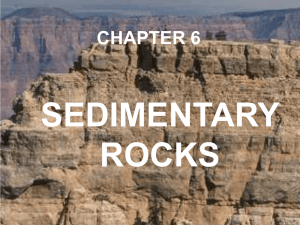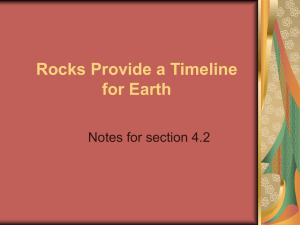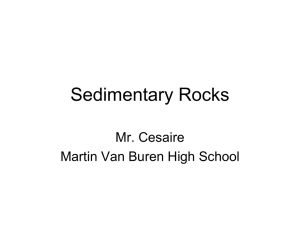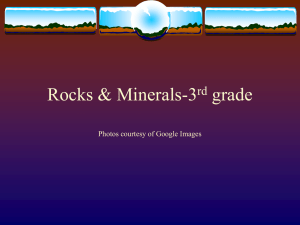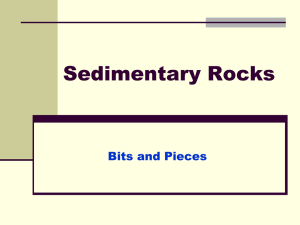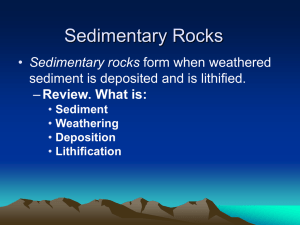Sedimentary Rocks
advertisement
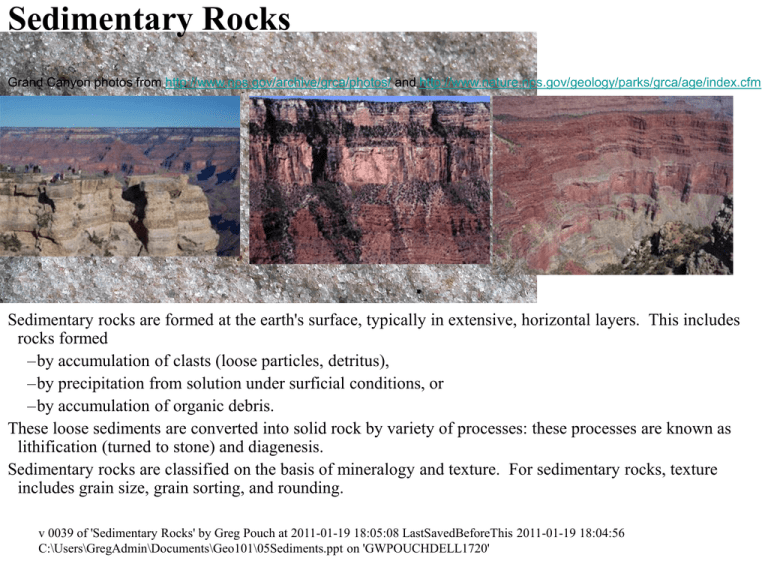
Sedimentary Rocks Grand Canyon photos from http://www.nps.gov/archive/grca/photos/ and http://www.nature.nps.gov/geology/parks/grca/age/index.cfm Sedimentary rocks are formed at the earth's surface, typically in extensive, horizontal layers. This includes rocks formed –by accumulation of clasts (loose particles, detritus), –by precipitation from solution under surficial conditions, or –by accumulation of organic debris. These loose sediments are converted into solid rock by variety of processes: these processes are known as lithification (turned to stone) and diagenesis. Sedimentary rocks are classified on the basis of mineralogy and texture. For sedimentary rocks, texture includes grain size, grain sorting, and rounding. v 0039 of 'Sedimentary Rocks' by Greg Pouch at 2011-01-19 18:05:08 LastSavedBeforeThis 2011-01-19 18:04:56 C:\Users\GregAdmin\Documents\Geo101\05Sediments.ppt on 'GWPOUCHDELL1720' Sedimentary Rocks Processes Clastic 3 Clastic Processes 1 4 Clastic Processes 2 5 Clastic Processes 3 6 Chemical Processes 7 Accumulation 8 Properties of Sediments 9 Properties> Texture = Size and Shape 10 Properties>Mineralogy 11 Properties>Sedimentary Structures 12 Interpretation of sedimentary rocks 13 [Genetic] Classification of Sedimentary Rocks 14 Classification of Sedimentary Rocks 15 Classification of Sedimentary Rocks > Coal, Evaporites, Chert 16 Classification of Sedimentary Rocks>Carbonates 17 Classification of Sedimentary Rocks > Siliciclastic 18 Classification of Sedimentary Rocks 19 Lab Classification of Sedimentary Rocks 20 Lab Classification of Sedimentary Rocks>Siliclastic 21 Lab Classification of Sedimentary Rocks => Carbonates 22 Lab Classification of Sedimentary Rocks> Examples Clastic Processes 1 • Erosion, Transportation, and Sedimentation –Erosion is beginning-to-move the particle. –Transportation is moving the particle. –Sedimentation/deposition is stopping (dropping it) • The agent and duration of transportation and deposition strongly influence the character and distributions of the sediment, so identifying and understanding various means and systems of transportation is useful in unraveling geologic history and finding mineral deposits. Clastic Processes 2 • The maximum "size" of particle that can be carried in a flow under a given set of conditions (mainly velocity) is the competence. The faster the flow, the higher the competence (larger particles are carried). Particles smaller than the maximum size are also carried. • "Size", for transportation of sediments, refers to hydraulic size, which includes diameter, density, and shape. A particle of low-density is hydraulically equivalent to a higher density particle of lesser diameter. This is why gold and diamonds settle out with coarse sand and can be extracted by panning these auriferous and diamondiferous sediments. –When a flow slows down a little, it drops only the largest particles and deposits well-sorted sediment. –When a flow slows down a lot, it drops a whole range of particle sizes (everything above the new competence.) and deposits poorly-sorted sediment. –In stream channels, the velocity varies gradually and deposits fairly well-sorted sediments; alluvial fans have a sudden decrease in velocity and deposit poorly-sorted sediments. • Capacity is the total amount of sediment a flow can carry. If a flow slows and drops sediments then goes back to its previous speed, it will erode until it is back at capacity. Clastic Processes 3 • Modes of transportation: Sediment can move by –Bedload: Rolling, Tumbling, Dragging –Saltation Particles move in a series of hops: it moves, stops, gets picked up again. Leaves in wind. –Suspension Particles kept in fluid by small-scale turbulence. Particles settle very slowly. Dust. –Solution No solid particles, just dissolved ions. • Winnowing: subjecting sediment to a size-sensitive process repeatedly. –Results in better-sorting than a single pass through the process. –Winnowing is common in beaches, where each wave transports the sediment a short distance, and in eolian environments, where winds keep acting on the sediment. Results in very well-sorted sediments. • Lighter particles can be transported (often carried away in suspension), leaving behind coarser particles, often called a “lag deposit”. Chemical Processes • Precipitation Opposite of dissolution. Ions from solution form solid crystals. Can be abiogenic (rare, halite and gypsum) or biogenic (common: limestone, chert). Chemical sedimentary rocks are classified primarily on mineralogy, secondarily on texture and structure. Most chemical rocks have interlocking grains like an igneous rock. Biogenic precipitation usually occurs in the water above the site of deposition, and the particles settle (shells of plankton, mollusks, …), in which case the sediments have a clastic texture. Abiogenic precipitates (evaporites) usually form in place. • Lithification Sediments are, by definition loose. Lithification is the process of converting these into solid rock. Clays are “lithified” into shale mainly by pressure and alignment of grains. Other clastic rocks are lithified mainly by precipitation of cements, usually calcite or quartz precipitating in pore space. • Diagenesis is processes that change sediments after deposition, and can include alteration in mineralogy, such as converting clays into more micaceous minerals, growing feldspar from clays and dissolved ions, and pressure solution of the edges of grains. Accumulation •Sedimentary rocks can be accumulated remains of organisms that died in place. This can happen with corals and sponges, resulting in boundstone limestone or chert, but especially coal, which is accumulated plant remains and requires an anoxic (reducing) environment, typically a swamp. Pictures from flickr.com, searched on coral reef and coal swamp Properties of Sediments Often, the properties of a sediment are inherited directly from the source material. For example, erosion of a well-sorted, wellrounded quartz sandstone yields well-sorted, well-rounded quartz sand, regardless of the sedimentary environment. (Along with some silt or clay-sized quartz powder.) • Texture – Size – Sorting • Rounding (rounded vs. angular) • Mineralogy • Sedimentary structures Properties>Size and Shape • Texture Clast Size is named using the Wentworth scale (table 6.1) as gravel, sand, silt, or clay. Size mainly indicates competence of the depositing environment. –Sorting refers to uniformity of size. Very-well sorted sediment has only a small range of sizes, such as only grains 1.0-2.0 mm in diameter. Very poorly-sorted sediments shows a huge variation in clast size. Sorting indicates the type of transportation: well sorted sediments indicate gradually-changing velocities (like a stream) or extensive re-working (like a beach). • Rounding During most types of transportation, sedimentary particles collide with each other. The corners are more easily broken off than the centers, so they become more rounded with continued transport. Fragments might be angular if coming straight from an igneous or metamorphic source, or if moved by ice. Transport by wind or water results in rapid rounding Rounding indicates duration of transport ("distance" from source terrane) or is inherited. Properties>Mineralogy Sedimentary processes result in an amazing degree of chemical refinement, yielding pure quartz, pure calcite, or pure clay from igneous rocks with many different minerals. Only a few minerals are common in sedimentary rocks: quartz, calcite, dolomite, and clay minerals. Other minerals such as iron oxides, aluminum oxides, and organic matter are important minor components of many sedimentary rocks, and still other minerals, such as halite, gypsum, and borax, make up entire rocks and are rare but important. –Carbonate minerals include calcite and dolomite (about 10% of sediments). –Evaporite minerals are those that form from evaporation of seawater or other water and include gypsum, halite, and borax. They are rare but important economically and as indicators of sedimentary environment. • Most sedimentary rocks are composed of siliciclastic fragments of quartz, feldspars, and clay minerals. Clay/shale accounts for 80% of sediments (look at the composition of granite or basalt and the products of weathering). Quartz/sandstone accounts for about 10%. In an arid climate, quartz and carbonates are resistant to erosion, and form cliffs; shales/clays form slopes. (In a humid climate, limestone is less resistant to weathering). In a place like the Grand Canyon, you notice the cliffs, but the slopes aren’t noticeable, even if they make up 80% of the rock column. Properties>Sedimentary Structures • Primary sedimentary structures form at time of deposition –Bedding Each change in depositional conditions or pause in deposition is likely to cause a mechanical discontinuity in the sediments, that becomes the layering/stratification characteristic of sedimentary rocks. –Ripples and cross-bedding –Fossils –Graded bedding –Mud cracks • Secondary sedimentary structures form after deposition –Sand dikes –Geodes Interpretation of sedimentary rocks The mineralogy, texture, and sedimentary structures of sedimentary rocks provide valuable clues to both the source region and the immediate environment of deposition. Texture and mineralogy of a sedimentary rock can be directly inherited from the source region or source terrane, or can be the result of weathering and sedimentary processes. Inherited properties tell you nothing about the environment deposition, but do tell you about the source. As sediment is transferred further from the source terrane it becomes more rounded, typically finer grained, and the minerals are more weathered (less feldspar and other unstable minerals, more clay). By examining the texture and mineralogy of sediments and their distribution, the geologist is able to locate the source terrane. (More fines and more intensely weathered means further from source) By interpreting the mineralogy and perhaps lithic fragments, the geologist is able to describe the geology of the source terrane. The distribution of sediments size and sorting (texture) provide valuable clues about the environment of deposition. For example, thin meandering strings of well-sorted sand set in a matrix of silt and clay are likely the result of deposition by a river system. Color, especially of fine-grained sediments, can provide valuable clues to whether the environment of deposition was oxidizing or reducing. Oxidizing environments yield sediments that are brown, red, and yellow. Reducing environments, such as swamps, yield sediments that are black, green, or gray. Classification of Sedimentary Rocks Sedimentary rocks can be classified on their origin, mineralogy, or texture, or some combination of these. Super-type? • organic (coal) • evaporite • chert • carbonate • clastic Classification of Sedimentary Rocks Super-type: organic (coal), evaporite, chert, carbonate, clastic? •Coal: assign grade based on color and luster •Evaporite: these are usually monominerallic and named after the mineral, as in halite/rock salt, gypsum, sylvite (KCl), etc. •Chert (no subtypes) •Carbonates (calcite and dolomite) –Determine mineralogy, grain size, and look for features such as fossils and oolites. –The rock-name will be limestone if it's made of calcite, or dolomite/dolostone if it's made of dolomite. –If the crystals are too small to sparkle, it's micritic or micrite; if you can see sparkly crystals, it's sparitic or sparite. –If it has abundant fossils, call it fossiliferous or bio-, if it has oolites, call it oolitic or oo-. If you see gravel sized fragments it's –rudite. –So, if you have calcite with large fossils and no sparkles, you have a biomicrudite or a fossiliferous micritic limestone •Siliciclastic sediments Classified first on grain-size and sorting, secondarily on minerals. –Gravel conglomerate if rounded, breccia if angular –Sand sandstone <15% fines, >15% fines, -wacke. Identify minerals. • Quartz>Quartz/quartzose. • Significant feldspar>arkose/arkosic • Rock fragments>lithic • If you have lots of rock fragments and lots of matrix, it's a graywacke. –Fines (silt and clay), a.k.a. mud • No fissility > mudstone • Significant silt > siltstone • Clay, fissile (splitting into thin sheets) > shale –Tuff (pyroclastic fragments) may be considered a sedimentary or igneous rock and resembles arkose. Classification of Sedimentary Rocks > Coal, Evaporites, Chert • Coal: assign grade based on color and luster Lowest grade –Peat Brown, identifiable wood –Lignite Brown, woody material –Bituminous dirty, clastic –Anthracite shiny, glassy –Graphite Not really coal anymore. This is a grayish or black metallic mineral form of pure carbon Highest grade • Evaporite: these are usually monominerallic and named after the mineral, as in halite/rock salt, gypsum, sylvite (KCl), etc. • Chert (no subtypes) Classification of Sedimentary Rocks>Carbonates Carbonates (calcite and dolomite) –Determine mineralogy, grain size, and look for features such as fossils and oolites. –The rock-name will be limestone if it's made of calcite, or dolomite/dolostone if it's dolomite. –If the crystals are too small to sparkle, it's micritic or micrite; if you can see sparkly crystals, it's sparitic or sparite. –If it has abundant fossils, call it fossiliferous or bio-, –if it has oolites, call it oolitic or oo-. –If it has fecal pellets from reef-eating organisms (like fish that eat coral), it's pel–If you see gravel sized fragments it's –rudite. –So, if you have calcite with large fossils and no sparkles, you have a biomicrudite limestone or a fossiliferous micritic limestone Classification of Sedimentary Rocks > Siliciclastic • Siliciclastic sediments Classified first on grain-size and sorting, secondarily on minerals. –Gravel • conglomerate if rounded, • breccia if angular –Sand How much fines (silt and clay) • <15% fines: clean, arenite or sandstone • >15% fines: dirty, wacke. Identify minerals. –Quartz>Quartz/quartzose. –Significant feldspar>arkose/arkosic –Rock fragments>lithic –If you have lots of rock fragments and lots of matrix, it's a graywacke. –Fines (silt and clay), a.k.a. mud • No fissility > mudstone • Significant silt > siltstone • Clay, fissile (splitting into thin sheets) > shale –Tuff (pyroclastic fragments) may be considered a sedimentary or igneous rock and resembles arkose, but with more unstable minerals like biotite and muscovite. (The giveaway that it's tuff rather than arkose or such is the unstable phenocrysts.) Classification of Sedimentary Rocks Super-type: organic (coal), evaporite, chert, carbonate, clastic? • Coal: assign grade based on color and luster • Evaporite: these are usually monominerallic and named after the mineral, as in halite/rock salt, gypsum, sylvite (KCl), etc. • Chert (no subtypes) • Carbonates (calcite and dolomite) – Determine mineralogy, grain size, and look for features such as fossils and oolites. – The rock-name will be limestone if it's made of calcite, or dolomite/dolostone if it's made of dolomite. – If the crystals are too small to sparkle, it's micritic or micrite; if you can see sparkly crystals, it's sparitic or sparite. – If it has abundant fossils, call it fossiliferous or bio-, if it has oolites, call it oolitic or oo-. If you see gravel sized fragments it's – rudite. – So, if you have calcite with large fossils and no sparkles, you have a biomicrudite or a fossiliferous micritic limestone • Siliciclastic sediments Classified first on grain-size and sorting, secondarily on minerals. – Gravel conglomerate if rounded, breccia if angular – Sand arenite <15% fines, >15% fines, -wacke. Identify minerals. • Quartz>Quartz/quartzose. • Significant feldspar>arkose/arkosic • Rock fragments>lithic • If you have lots of rock fragments and lots of matrix, it's a graywacke. – Fines (silt and clay), a.k.a. mud • No fissility > mudstone • Significant silt > siltstone • Clay, fissile (splitting into thin sheets) > shale – Tuff (pyroclastic fragments) may be considered a sedimentary or igneous rock and resembles arkose. (look for phenocrysts) Lab Classification of Sedimentary Rocks The scheme used in lecture, in the textbook, and in the lab manual is genetic rather than descriptive. In particular, the over-ruling of clastic textures for limestones causes confusion. The big problem is the concept of clastic vs. chemical vs. other. If you think about oolitic limestone or coquina (shell fragments), it's clearly clastic, but we don't classify it that way. Fortunately, calcite, dolomite, gypsum and other evaporites are all softer than glass, but quartz and feldspar are harder. So we can almost test for “siliciclasticness” with a nail. Unfortunately, clay is also softer than steel, and chert is harder. But we do have a series of simple tests that we can perform in order to identify the minerals: don’t perform extra tests or tests out of order. • 1) Is it coal? If yes, Coal. Classify grade based on color and luster, DONE. If no, goto question 2. • 2) Is it harder than glass or steel nail? Yes, harder than steel. • Is it featureless but "aphanitic"? (and maybe has conchoidal fracture)? Yes> Chert >DONE No > Siliciclastic see Siliciclastic detail No (softer than steel) • Does it fizz in HCl? (Scratch some, and put drop on powdered and unpowdered rock) Yes => Calcite => Limestone see Carbonate detail Yes, when powdered => Dolomite see Carbonate detail No • Crystals visible? (Interlocking crystals like an igneous rock, but typically soft minerals) No > clay, siliciclastic detail Yes > evaporite of some sort. Identify the mineral. gypsum?, halite?, other? Some fizzes, some doesn't –If it's from little strings in the rock, you're looking at calcite-cemented siliciclastic –If it's from the whole rock, and you're sure it's not dolomite, you have a clay-calcite mixture. This is common, because the shells in chalk are in the clay size range, so you can accumulate both in the same rock. Calcareous siliciclastic or clayey chalk Lab Classification of Sedimentary Rocks>Siliclastic Siliciclastic Detail Classified first on grain-size and sorting, secondarily on minerals. • Tuff? (pyroclastic fragments) may be considered a sedimentary or igneous rock and resembles arkose, but has more unstable phenocrysts, like biotite, muscovite, sanidine (KSpar found in tuffs), and opal and volcanic glass. (Should key out as fines, but gravel is possible) • Size? Gravel • Rounding? conglomerate if rounded, breccia if angular Sand • % fines? 15% fines or less than 15%, _ sandstone (or arenite) fines more than 15% -_ wacke. • Minerals? Quartz => Quartz/quartzose (if overwhelming quartz, like >80%) Significant feldspar => arkose/arkosic Rock fragments => lithic Special case: If you have lots of rock fragments and lots of matrix, it's a graywacke=lithic wacke Fines (silt and clay), a.k.a. mud • No fissility > mudstone • Significant silt (gritty) > siltstone • Clay (smooth), fissile (splitting into thin sheets) > shale [common in reality, rare in hand specimens] Lab Classification of Sedimentary Rocks => Carbonates Carbonates (limestone if calcite, dolomite or dolostone if dolomite) Named for mineral, crystal size (sparite/micrite), and special features (0 to as many as are there). • Does it sparkle? Yes => sparitic __spar_ite No => micrite __micr_ite • Any special features? • Fossils? => bio_ • Oolites? => oo_ • Fecal pellets (from coral-eating fish)? => pel_ • Gravel sized clasts? => _rud_ • Limestone clasts? => intra_ • Mineral Calcite => ___ limestone Dolomite =>___ dolomite Then combine everything into one name, like biomicritic limestone Lab Classification of Sedimentary Rocks> Examples • Scratches nail, has conchoidal fracture, and no visible grains, but looks "grainy" like bread or wood, so chert • Doesn’t scratch nail, fizzes in HCl, so Carbonate/limestone. Sparkles, has some fossils, so biosparitc limestone, or calcareous biosparite. • Scratches nail, has visible grains, so Siliciclastic. Mostly quartz, but 25% feldspar and no fines, so arkosic arenite or arkose. • Fizzes poorly in HCl (dolomite), does not sparkle (micrite), has ooliths (oo) so "dolomitic oomicrite" or “oomicritic dolomite“ • Scracthes nail, has grains, sand-sized quartz grains, no fines. "Quartz sandstone" or "quartz arenite“ • Softer than nail, interlocking crystalline texture evaporite, tastes like salt: halite • Harder than nail, visible grains, so siliciclastic. Particles are mostly sand size, but around 20% clay and silt and the rock is poorly sorted and dense-looking. Some grains are rock fragments, there’s lots of feldspar too. So lithic wacke or graywacke. Sedimentary Rocks • • • • Weathering breaks rocks down to new, more stable minerals and solutes. These solutes and minerals can be transported and deposited to form sediments, and lithified to form sedimentary rocks. Sedimentary rocks are classified based on texture, mineralogy, and, to some extent, origin. The source terrane and agent(s) of transportation/deposition determine the properties of the sedimentary rocks. Geologists spend much effort determining the source terrane and depositional environment from the sedimentary rocks left behind.


